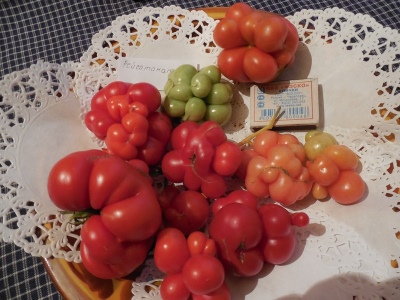
- Authors: Germany
- Name synonyms: Reisetomate, Garlic Tomatoes, Transylvania Traveler, Reisetomate, Voyage, Reisotomat
- Category: grade
- Growth type: indeterminate
- Appointment: fresh consumption
- Ripening period: mid-early
- Ripening time, days: 108-110
- Growing conditions: for open ground, for film greenhouses, for greenhouses
- Bush size: tall
- Bush height, cm: up to 300
Indeterminate tomatoes are very popular. However, these cultures deserve the most attention. And the Reysetomate tomato is no exception - only with a competent approach, it is able to give a good result.
Description of the variety
The Racetomite tomato has a number of alternative names:
Reystomat;
Garlic Tomatoes;
Reisotomat;
Traveler from Transylvania;
Voyage;
Reisetomate.
As mentioned earlier, this variety demonstrates the classic indeterminate developmental dynamics. You can meet him in conventional and plastic greenhouses. Planting in ordinary gardens, however, is also not prohibited. The bushes of such a tomato can grow up to 3 m. They invariably show very powerful growth wherever at least minimally favorable conditions are created.
The main qualities of the fruit
The red berries of Reisetomite will immediately attract attention with their large size. Their mass ranges from 150 to 400 g. The geometry is also unusual - the fruits are formed from intergrown slices, resembling simple cherry tomatoes. Up to 18 fruiting clusters can develop on the main stem. Remarkably, it will take over 30 days to keep the crop in the refrigerator.
Taste characteristics
The seeds inside the fruit are almost absent and do not have any significant effect on their taste. Consumers celebrate the excellent sweetness of Reisetomite. At the same time, it is often said that it has a tomato-fruity taste.
Ripening and fruiting
The ripeness of berries is usually reached 108-110 days after the emergence of early shoots. This property makes it possible to classify the variety as a mid-early group. After the start of fruiting, it will take a very long time. The exact timing of the continuation is not named in the official description.
Yield
In the official description from the suppliers of the planting material, the level of productivity is not mentioned. At the same time, third-party sources mention that it is 8-9 kg of berries per 1 sq. m. However, to achieve such a result, you still need to work. Basically, the harvested crop is consumed fresh.
The timing of planting seedlings and planting in the ground
It is necessary to sow seeds for seedlings from 10 to 15 March. Usually seedlings are ready for open field cultivation between 10 and 15 April. However, in reality, the situation can change significantly. The readiness time is influenced not only by the care of the farmers, but also by the weather.

Growing tomato seedlings is an extremely important process, because it largely depends on whether the gardener will be able to harvest at all. All aspects must be taken into account, from seedbed preparation to planting in the ground.
Landing scheme
Experts unequivocally recommend planting Reysetomate tomatoes according to the 600x700 mm system. The search for other options is obviously inappropriate. For 1 sq. m planted no more than 3-4 bushes.

Growing and care
It is impossible to count on a good collection without eliminating excess stepchildren. Plants will additionally have to be tied to a support and led into 3 stems. Due to the weak frost resistance in the middle lane, in the Urals and in regions with an even more difficult climate, shelters will have to be used. Treatment with fungicides helps to increase resistance to diseases. It is carried out 14 days after planting in open ground.
Preparing the soil for planting implies its saturation with organic matter. For 1 sq. m poured about 10 kg of peat. Planting should be watered approximately 1-2 times a week. More precisely, it can be said only taking into account the specific weather and the degree of desiccation. The first feeding is carried out with nitrogen mixtures.
After watering, the soil is loosened immediately. Doing it with a rake or with your hands is a personal choice of the gardener. Top dressing more than 3-4 times during the growing season is impractical. This should be done in the morning. Then the plants are watered.
The second feeding is carried out with superphosphate mixed with potassium sulfate. It is made during flowering or immediately after. Reysetomate is protected from pests with Aktellik or Fitoverm. Irrigation with soapy water helps from improvised means. An important preventive measure is the combination of competent crop rotation with decontamination of the land.




A plant needs different micronutrients at each stage of growth. All fertilizers can be divided into two groups: mineral and organic. Folk remedies are often used: iodine, yeast, bird droppings, eggshells.
It is important to observe the rate and period of feeding. This also applies to folk remedies and organic fertilizers.



























































































